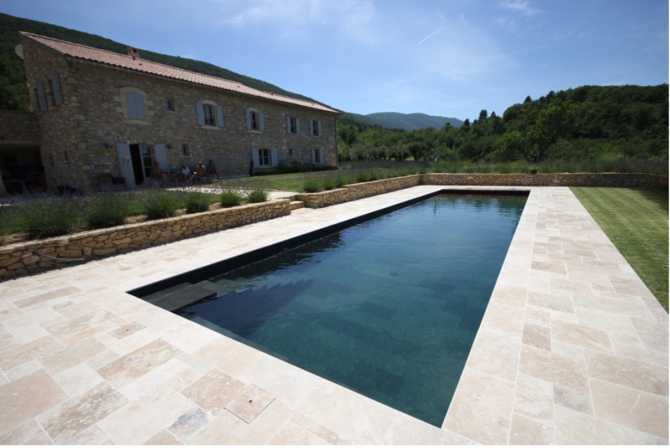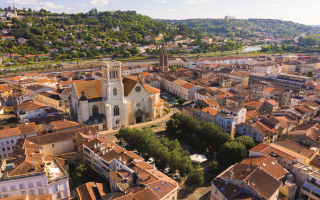Why should I choose a fibreglass swimming pool?

Fibreglass pools fall into the bracket of “one piece pools” and, more commonly in France, “monobloc”. That is to say they arrive at your property all in one piece!
Fibreglass pools are a great option for a property in France. They can be installed in varying terrains, they are quick to install, long lasting, minimal maintenance, cost efficient, environmentally friendly, diverse and can be a stunning addition to your property. Below we breakdown these advantages and also address a few disadvantages. For you to have an idea of cost, we have put together a cost guide too.
INSTALLATION SCOPE & TIME – Often people are put off by fibreglass pools because of access and terrain. However nowadays there are manufacturers of higher end fibreglass pools which allow you to even install it above ground, due to highly spec’ed reinforcing systems. Also, the delivery of fibreglass pools in France has been done by 50mtr crane and even helicopter! It is no lie when companies tell you your Fibreglass pool can be installed in a week. Of course you have to bear in mind planning applications (declaration preamble) and design surveys. But unlike a concrete pool build which can take anywhere from 2-4 months – and is often weather dependent – a fibreglass pool can be ready to swim in a week after it arrives. Often in France it is difficult to manage multiple contractors, and when building a pool from concrete or other trade intensive materials and finishes (PVC liners etc), this can cause long delays. A fibreglass pool removes this stress. A competent fibreglass pool company will be able to provide you with a detailed programme from dig to swim, allowing you to plan the time you will spend at your property during the build period.
LONG LASTING – Like many material items, the amount one pays for it usually reflects the quality of the material and consequently how long it will last for. There are cheap options for Fibreglass pools, which are made from two or three layers of protection, and these will last on average 10yrs. Then there are the higher end fibreglass pools which have multiple layers, including reinforcement such as carbon ceramic. These types of fibreglass pools will outlive us all! Groundworks and the materials used for this will also add life to the fibreglass pool. Key tip: Only backfill using stabilised sand (14/1 sand/cement at 4% humidity) don’t let the pool builder convince you otherwise! And you can never have enough drainage!
MINIMAL MAINTENANCE – The finish/top coat (what you see when you look at the pool) of a fibreglass pool is referred to as the gel coat. The name is slightly misleading, as it feels hard not soft. However it is extremely smooth. So much so that algae cant grow on it. Unlike tiled or liner pool which requires endless brushing of the walls, a fibreglass finish gel coat pool will feel smooth not slimy. This also has a knock on effect on the amount of chemicals required to balance the water. Less algae means less chemicals, and therefore less maintenance. Finally, liner pools will need to have the liner replaced after 5-8yrs; with a high quality fibreglass pool, this is not the case.
COST EFFICIENT – With the features discussed above, it is clear that – particularly on a higher end model – it would be money well spent. Coupled with the fact that far less electricity is required to run pumps and also fewer chemicals and maintenance costs are involved. If your fibreglass pool is heated, the higher quality Fibreglass pools have multiple layers which offer a high level of insulation, also come with inbuilt covers which can have solar heating slats or even insulated ones. All these features will reduce your demand for heating and thus save you electricity. Covers reduce evaporation too, so you will save on paying extra for water. Again, the more experienced and higher end companies will be able to give you a guide on your running costs and might even suggest a payback period.
ENVIRONMENTALLY FRIENDLY – Less chemicals means that less chemicals will find there way into the ground. Less electricity means less energy use to provide this power. Installing a product once in a lifetime is better than multiple replacements/renovations. The ‘cradle to grave’ life cycle of a high quality fibreglass swimming pool is incomparable with any other type of swimming pool when it comes to its environmental impact.
DIVERSE & STUNNING – Fibreglass pools in France are more often than not associated with being propped up on the side of the road and aren’t very attractive to look at…nowadays though it is a much more diverse market. There are many more colour options and colour systems such as Nova finishes which refract sunlight in a way which subtly changes the pools colour. LED lighting has reduced in size and is a stunning addition. With low and no chemical filtration available on the market in France, there is no reason why your water isn’t always sparkling clear. Counter currents are an available addition too, allowing you to opt for a smaller pool but a larger scope of swimming. Some ranges of the high end fibreglass pools have sloping bases, in-built ledges for relaxing, and as mentioned, in built automatic covers. This once ‘mosh’ product is now a value-adder to any French property.
Of course there are also some disadvantages too.
CAPITAL COST – Although with the higher end fibreglass pools in France there could be considered to be a payback period, the initial capital outlay is often more than a concrete liner pool. Delivery costs can also add to this.
BESPOKE SHAPES – These can be limited and also the maximum length available is around 13mtrs. The fact that fibreglass pools are manufactured from molds means that the range of shapes and sizes is limited.
COST GUIDE FOR A 8 X 4 FIBREGLASS POOL:
- POOL = €8,000 – €15,000
- GROUNDWORKS = €4,000 – €8,000
- COVER = €1000 – €6000
- LIGHTS & FITTINGS = €500 – €3000
- FILTRATION = €2000 – €8000
Total cost approx €16K – €42k
Of course quality varies massively, hence the cost range.
This content comes courtesy of Gaius Terra & Aqua.
Share to: Facebook Twitter LinkedIn Email
Leave a reply
Your email address will not be published. Required fields are marked *





REPLY